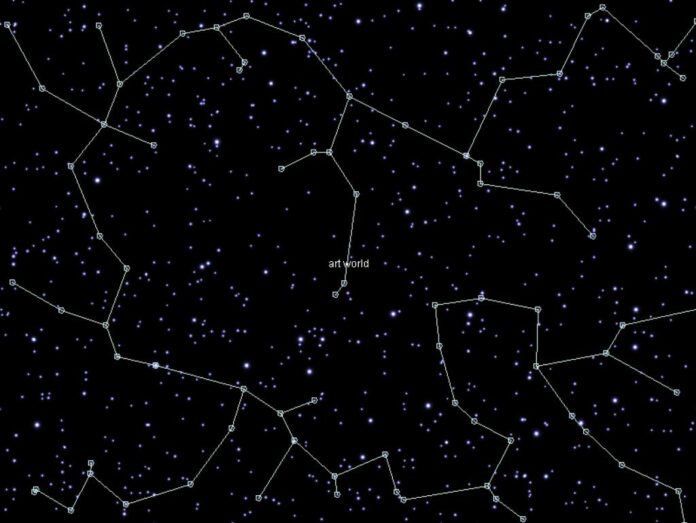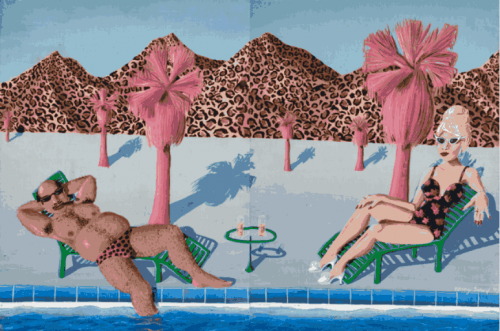In 1999, programmer Alex Galloway, artist Mark Tribe, and researcher Martin Wattenberg built an all-encompassing online archive for Rhizome. The platform had launched three years earlier as an email list for discussions about new media art, and the trio’s approach to logging its dialogues was suitably visual, hinging upon digital technology. Titled StarryNight, the resulting interface allowed users to navigate a constellation of stars across a digital night sky, each of which was linked to a keyword and associated emails.
Alas, despite its significance as a piece of Net art, StarryNight would end up nonfunctional, its text corpus lost for more than a decade—until now. Rhizome, now affiliated with the New Museum, has resurrected the interface, partially recovering its text content and enabling it to run on operating systems later than Windows 1998. And in a further move, the team has brought the work up to date with the Web3 era.

Postcards From StarryNight #100. Courtesy of Rhizome and TRLab.
On June 28, Rhizome, in partnership with Web3 platform TRLab, launched “Postcards From StarryNight,” a now sold-out collection of 151 NFTs minted from museum-quality screenshots of the restored version of StarryNight. Each of these still images relates to a distinct keyword—from “meme” to “performance” to “social space”—making them unique, one-of-one pieces. Proceeds from the sale, now totaling 5 ETH (about $9,848) in volume, will go toward supporting Rhizome’s archival and commissioning work.
“That project is very significant in our history,” Michael Conner, co-director of Rhizome, told Artnet News about StarryNight. “We’re very proud to be sharing it in this way to tell the story of our preservation work and our history to a broader community.”
The NFT drop inaugurates Rhizome and TRLab’s new joint venture Seed, positioned as an educational journey through the history of generative art or more broadly, creative coding, which StarryNight deployed. Visitors to Seed’s website can dig into a brief history of the generative space as seen through Rhizome’s archive of Net art, throughout which are scattered “Seedlings” or digital collectibles that can be added to their digital wallets.

Screenshot from Seed’s history of generative art. Courtesy of TRLab.
As a born-digital organization, Rhizome is itself no stranger to the NFT space. Its flagship event Seven on Seven notably incubated Kevin McCoy’s Quantum (2014), widely regarded as the first art NFT. Seed, however, marks its deeper engagement with the Web3 space that took some deep consideration, according to Connor.
“In 2021, we were watching the boom happen with a lot of knowledge and perspective on it, but not necessarily an understanding of how we could best engage as an institution. We were taking it slow and I think we still are,” he explained. “But we’ve seen a lot of really lasting communities forming in crypto that we want to engage with as Rhizome.”
In this, Rhizome has leaned on TRLab to craft an NFT experience backed by an educational aspect—just as it did for The Calder Question, a project launched with the Calder Foundation that aimed to teach visitors about the American sculptor, while inviting them to purchase NFTs. With Seed, the subject matter goes deep into the heart of the digital art space and marketplace, which have embraced the generative medium in a big way.
“Within the digital art collecting community, there are many newcomers not yet familiar with generative art’s long history or how it relates to Net art,” Audrey Ou, TRLab’s co-founder, told Artnet News. “As the term becomes more commercialized, it’s an ideal moment for Rhizome to share its educational and visual content with those who want to learn how the foundational artists got us to this moment, and where it might go next.”
This fall, following the release of “Postcards from StarryNight,” Seed 2 will feature a generative art collection that serves as Rhizome and TRLab’s genesis artwork, before Seed 3 unveils a series of artist commissions likewise focused on generative forms. The point, added Connor, is to further underscore “an incredible community of practice” that’s here to stay.
“People sometimes say, ‘oh, this is a hype cycle,’ but in my view, there’s so much strength and so much passion [in generative art],” he said. “There’s clearly people that care about software and code, and are going to be supporting this practice over the long haul. That’s what I really respond to.”

























